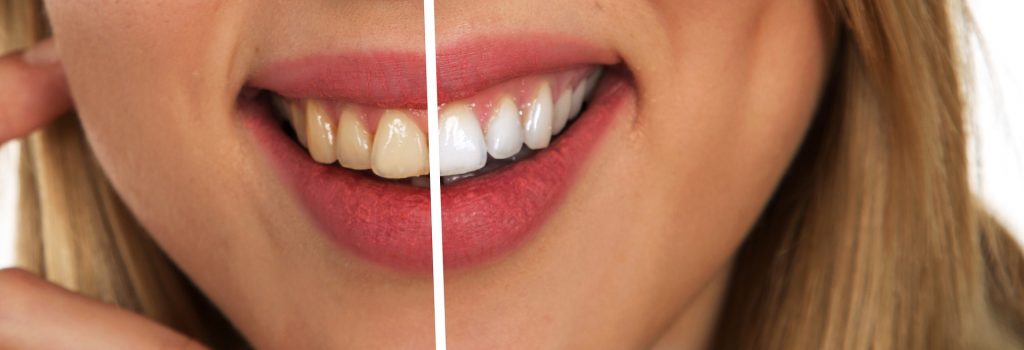
First and foremost, whitening your teeth is in and of itself not such a great idea. Why you ask? To whiten your teeth, the dentist has to whittle away a layer of your enamel. This common procedure that requires the use of whitening products containing hydrogen peroxide or carbamide peroxide (usually) that will eat at the enamel to make your teeth appear whiter and brighter.
But, here’s the thing. The thinner the enamel, the more likely your teeth will be sensitive. Know that pain you feel when you crush ice? Yep, that constantly. But let’s be honest, white teeth look way more appealing than dull, yellowish teeth. And there are some pros to teeth whitening.
The Pros:
When it comes to teeth whitening, most of the benefits are purely cosmetic. Having a white smile is believed to make you more attractive to other people. It can also make you more youthful. A brighter smile can also boost your self-esteem.
The Associated Risks and Side Effects

There are several side effects of getting a teeth whitening procedure, some of which include tooth sensitivity and gum irritation can occur. Others are:
- If the bleaching agent used is too strong, there is also risk of getting soft tissue burns on your gums, and an upset stomach.
- They are a multi-step process that can even wind up costing more than you budgeted. Things you’ll have to be treat before even getting your teeth whitened, is cavities and gum recession. When gums recede, the roots of your teeth are exposed and are generally yellow or discoloured. The problem is whitening gels do not work on the roots.
Now, imagine doing this at home! See why we vehemently oppose it? Not convinced? Okay, so let’s break this down and look at the pros and cons of doing this yourself.
At-home Bleaching
If you are going to bleach your teeth at home, you’ll need to find trays that fit onto your teeth and that contain peroxide. These trays contain the gel that bleaches the enamel of the tooth.
If you don’t want to use trays, there’s still the option of getting strips. These strips also contain bleaching gels and have to be placed on your teeth.
But Is It Safe to Do this at Home?
While this usually does not provide the best results, it is not necessarily dangerous. You just need to ensure you follow every of the manufacturer’s instructions because, if not used properly, the peroxide in these products can irritate and harm your gums.
if you want safer options, you can pick other products, such as toothpastes and whitening rinses. Bear in mind that they won’t have the same results as tray-based whiteners and in-office whitening treatment though. These products, while safe, also do not show results immediately.
Regardless of how you choose to do the whitening, it is always good to see your dentist first. A consultation will establish whether teeth whitening is safe for you.
The Cons
1. Results
Under the right circumstances, it is possible to achieve good results even with DIY teeth whitening kit. But that sad, the end result will never compare with an in-office whitening treatment. Plus if you have yellow and brown teeth, you’ll face even more difficulties getting your teeth to all have the same shade.
2. Safety
It’s impossible for you to know whether your teeth and gums are healthy enough to be able to sustain the harsh bleaching you are about to subject them to. If you do this in-office, on the other hand, the dentist will conduct a thorough oral health evaluation and determine if you are a good candidate for teeth whitening and the kind of treatment that is best suited to you. From treating gingivitis to determining the number of shades that have to dropped for each tooth, your dentist can prevent you from feeling extreme pain and getting poor results.
3. Speed
It goes without saying that an in-office teeth whitening treatment is way quicker than any treatment you can give yourself at home. After having cleaned and prepped your teeth for the treatment, the bleach will be applied to your teeth and you will have to wait for at least 45 minutes. When doing the bleaching at home though, you will be expected to wear the trays for about an hour every day, over a period of five to 10 days.
That being said, teeth whitening at home has a few advantages:
The Pros
1. Cost
It goes without saying that at-home teeth whitening is a more economical option. From over-the-counter whitening toothpastes to over-the-counter mouth rinses and strips, you can expect to pay a maximum of $100 generally. Dentist-dispensed solutions, on the other hand, can go as high as $400!
But other than that one benefit, at-home bleaching has more cons than pros. Plus, that savings you make now can lead to more problems and more expenses down the line. So, if you really want to whiten your teeth, talk to your dentist. It’s really the best way to go about this.


